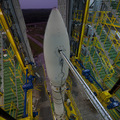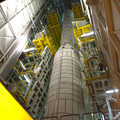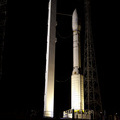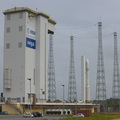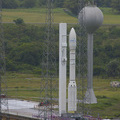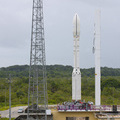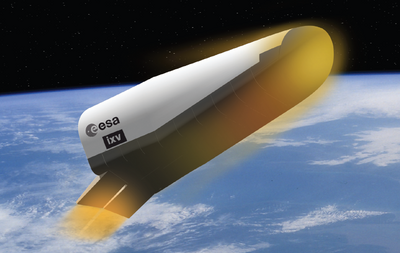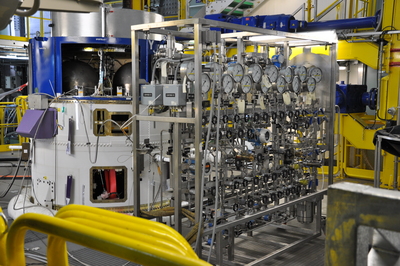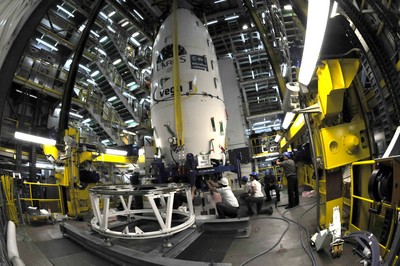- Joined
- Oct 11, 2009
- Messages
- 3,484
- Reaction score
- 403
- Points
- 123
- Location
- Utrecht
- Website
- www.spaceflightnewsapi.net
I noticed that there wasn't a thread about the first Vega launch. So here it is :thumbup:
For the people who don't know what Vega is: Vega is the new light weight launcher from ESA.
Vega's P80 first stage has left the spaceport's Booster Integration Building and has been placed on the launch pad. This is the first milestone for next years introduction of the Vega launcher. The first stage will test the ground-based infrastructure. It is also filled with a simulated load of solid propellant.

Transporting the P80 stage from the BIP to the launch site

Vega's launch site. (also being used by Ariane 1 and 3)

P80 booster arrives at launch site

P80 stage (+pallet) being railed in place on the launch platform

The new Vega launcher
---------- Post added at 09:14 PM ---------- Previous post was at 10:15 AM ----------
More info about the 4 stages of the launcher:
P80, first stage
Height: 10.5 M
Diameter: 3 M
Propellant mass: 88 tonnes
Thrust (max): 3040 kN
Nozzle expansion ratio: 16
Burn time: 107 s

Zefiro 23, second stage
Height: 7.5 m
Diameter: 1.9 m
Propellant mass: 23.9 tonnes
Thrust (max): 1200 kN
Nozzle expansion ratio: 25
Burn time: 71.6 s

Zefiro 9, third stage
Height: 3.85 m
Diameter: 1.9 m
Propellant mass: 10.1 tonnes
Thrust (max): 313 kN
Nozzle expansion ratio: 56
Burn time: 117 s

AVUM (Attitude and Vernier Module), fourth stage
Height: 1.74 m
Diameter: 1.9 m
Propellant mass: 550 kg
Thrust (max): 2450 N
Vacuum specific impulse: 315.2 s

Payload composite
Height: 7.18 m
Diameter: 2.6 m
Payload volume: 20 m3
Fairing mass: 470 kg

---------- Post added 11-07-10 at 03:22 PM ---------- Previous post was 11-06-10 at 09:14 PM ----------
For the people who don't know what Vega is: Vega is the new light weight launcher from ESA.
Vega's P80 first stage has left the spaceport's Booster Integration Building and has been placed on the launch pad. This is the first milestone for next years introduction of the Vega launcher. The first stage will test the ground-based infrastructure. It is also filled with a simulated load of solid propellant.
A special vehicle was used to transport the first stage. It was the same vehicle that also is being used to transport Ariane 5 boosters. The P80 stage was mounted atop of a pallet. This pallet was mounted atop of the vehicle. When the vehicle arrived at the launch site, the pallet with the booster was railed from the vehicle onto the launchpad by small rails.“The rollout involved the P80’s transfer from its Booster Integration Building to the Spaceport’s Vega launch zone, demonstrating the procedures that will be used with actual launcher hardware,” explained Claude-Henri Berna, the Arianespace Vega program director in French Guiana. “It was carried out under management of the European Space Agency and performed by the French CNES space agency, while also bringing together the launcher’s industrial contractors, along with Arianespace as the future operator.”

Transporting the P80 stage from the BIP to the launch site

Vega's launch site. (also being used by Ariane 1 and 3)

P80 booster arrives at launch site

P80 stage (+pallet) being railed in place on the launch platform

The new Vega launcher
---------- Post added at 09:14 PM ---------- Previous post was at 10:15 AM ----------
More info about the 4 stages of the launcher:
P80, first stage
Height: 10.5 M
Diameter: 3 M
Propellant mass: 88 tonnes
Thrust (max): 3040 kN
Nozzle expansion ratio: 16
Burn time: 107 s

Zefiro 23, second stage
Height: 7.5 m
Diameter: 1.9 m
Propellant mass: 23.9 tonnes
Thrust (max): 1200 kN
Nozzle expansion ratio: 25
Burn time: 71.6 s

Zefiro 9, third stage
Height: 3.85 m
Diameter: 1.9 m
Propellant mass: 10.1 tonnes
Thrust (max): 313 kN
Nozzle expansion ratio: 56
Burn time: 117 s

AVUM (Attitude and Vernier Module), fourth stage
Height: 1.74 m
Diameter: 1.9 m
Propellant mass: 550 kg
Thrust (max): 2450 N
Vacuum specific impulse: 315.2 s

Payload composite
Height: 7.18 m
Diameter: 2.6 m
Payload volume: 20 m3
Fairing mass: 470 kg

---------- Post added 11-07-10 at 03:22 PM ---------- Previous post was 11-06-10 at 09:14 PM ----------
Last edited:








